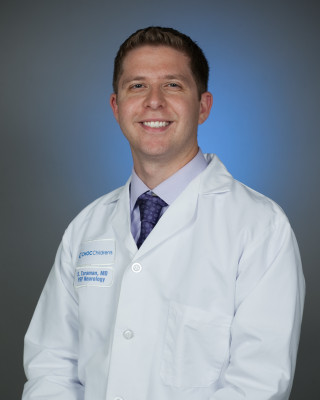Many might picture a stroke patient as middle aged or elderly, but

the reality is that the ailment occurs across the lifespan.
A stroke affects one in every 3,500 live births and six to 13 per 100,000 children per year. At CHOC, that translates to one or two patients per month outside the newborn period.
Among many risk factors, the largest for stroke in children include cardiac disease (19 percent); coagulation disorders (14 percent); and dehydration (11 percent). Multiple risk factors are present in up to 25 percent of pediatric stroke patients.
Atherosclerosis and modifiable risk factors that dominate adult stroke mechanism and treatment were nearly non-existent in pediatric stroke. However, in the past decade and a half, traditional cardiovascular risk factors for stroke in people ages 15 to 34 have been steadily increasing.
Placental diseases can cause perinatal arterial stroke, and perinatal stroke accounts for a large proportion of pediatric stroke morbidity. The first week of life carries the most risk for stroke and the majority of survivors have lifelong morbidity, most typically, hemiparetic cerebral palsy. Cognitive or behavioral disorders and epilepsy are also common.
Acute ischemic stroke (AIS) lesions are often multifocal, even in the absence of overt cardiac disease, which lends support to proximal embolic source. Many neonates with AIS have risk factors and presentations that overlap with hypoxic ischemic encephalopathy, and the two can co-occur.
Delayed diagnosis
Despite these occurrences and the inherent dangers, a lack of awareness prevails and diagnosis of childhood stroke is often significantly delayed. One study found up to a 28-hour delay in seeking medical attention from the onset of symptoms and a 7.2 hour delay after presentation before any brain imaging occurred (Lenn, et al, 2002).
Further complicating matters is that presentation can be subtle, varied and non-specific, and often occurs in the setting of a systemic illness. One study found the median time to diagnose AIS in neonates was 87.9 hours and 24.8 hours in children (Mackay, et al 2009). Another study saw that 19 of 45 children with a stroke did not receive a correct diagnosis until 15 hours after initial presentation, and in some cases, up to three months afterward (DeVeber, et all 2006).
Also, many other diseases mimic a stroke: A fifth of children presenting for evaluation of suspected acute stroke have a “stroke mimic,” rather than an actual stroke (Shelhaas, Pediatrics, 2006). Stroke mimics include migraines and delirium, as well as seizure and tumor.
Intervention
High-powered clinical trials that guide adult stroke management – including antiplatelet and anticoagulant strategies; chemical and mechanical thrombolysis; stroke unit care; and many others – do not yet exist for children.
Of 687 children enrolled in the International Pediatric Stroke Study (2011), 15 patients received tissue plasminogen activator (tPA): nine underwent intravenous tPA and six underwent intra-arterial tPA. The median time to treatment from onset was 3.3 hours for intravenous alteplase and 4.5 hours for intra-arterial alteplase.
Of those patients, four had intracranial hemorrhage (non-symptomatic); one died from brainstem stroke; one died from massive stroke with herniation; one was discharged without deficits; and 12 were discharged with neurological deficits.
Intravenous tissue plasminogen activator (tPA) needs more study for safety, dosing and efficacy before it can be fully applied to pediatric patients. Dosing in children cannot be extrapolated from adult data or existing pediatric data.
Limited pediatric safety and effectiveness data also exists around neurointerventional techniques like intra-arterial tPA and mechanical thromboectomy. Early intervention results in better outcomes, though success rates depend heavily on the operator’s experience.
Rehabilitation, recurrence
Similar to the adult stroke population, rehabilitation is multifaceted and comprises neuropsychology; developmental monitoring; educational intervention; and physical, occupational, and speech therapies. Most of the functional recovery occurs in the first two to three months. The quality of functional recovery is better in the pediatric population; however, the prognosis worsens as the lesion size increases.
The risk of recurrence following a stroke is up to 25 percent and highest in the first three months of onset. The lowest risk of recurrence is in perinatal and cryptogenic stroke.
Like any other condition, prevention of pediatric stroke is important and many patients will be placed on antiplatelet or anticoagulation. Interestingly, children with some, few or no vaccinations are shown to be at risk of stroke seven times higher than those who received all or most vaccinations.
CHOC has a collaborative team with protocols in place to recognize and treat pediatric stroke aggressively. Learn more about the CHOC Neuroscience Institute.




